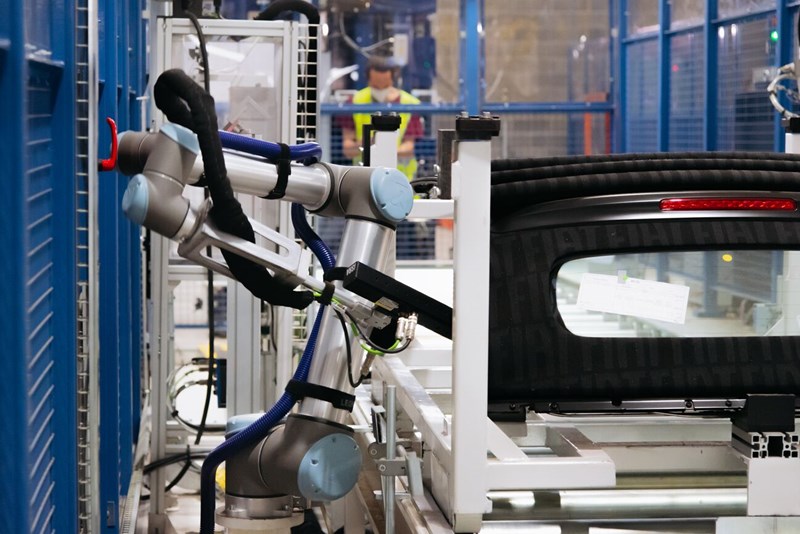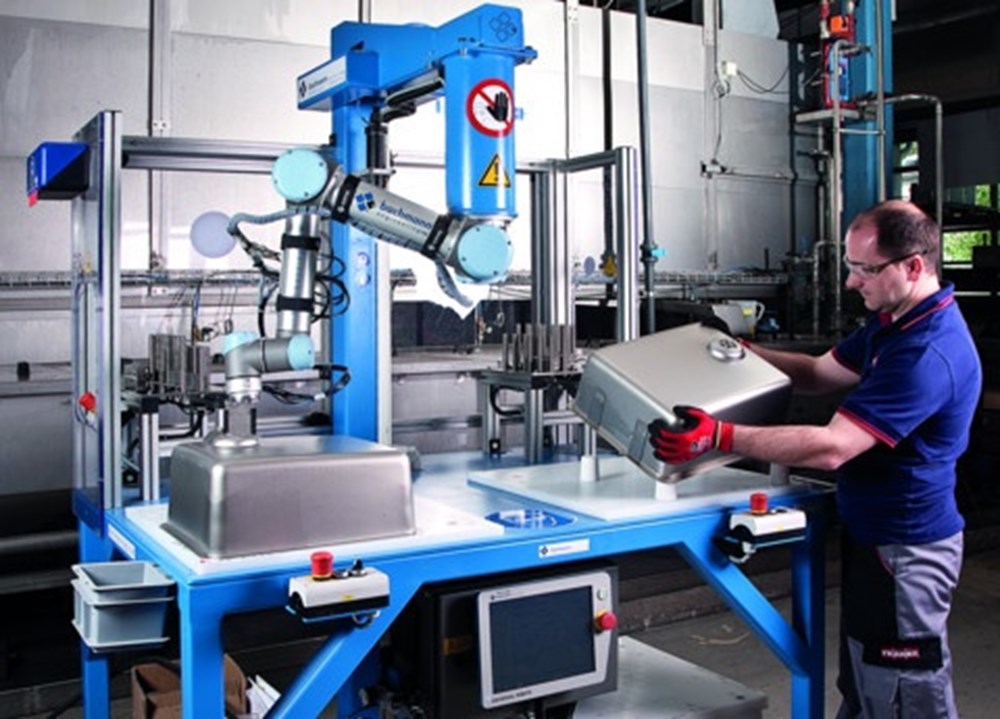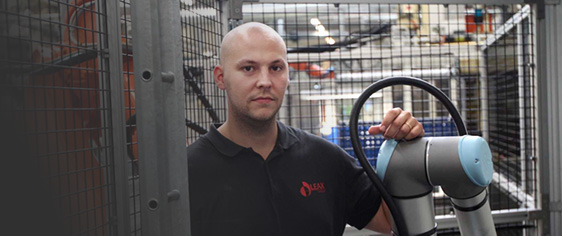With the industrial revolution, manufacturing industries underwent significant change - one of which was the introduction of robots and automation. They were introduced to the market to increase productivity and reduce operating costs. Today, robots are highly programmable and controllable to perform complex activities using artificial intelligence. Keep reading to understand the different roles of robotics in manufacturing, its impact, and its future. So keep reading.
Robotics in manufacturing is being used in multiple different areas due to automation. Robot applications in manufacturing include welding, assembly, shipping, handling raw materials, and product packing. For this reason, multiple manufacturers are leveraging robotic automation for an increased number of tasks.
Now, you might be wondering, are robots too expensive for your business? Or is your business too small to make use of robots? Are robots in manufacturing challenging to program and operate? Will it eliminate human workers from their jobs?
The answer to all the above questions is "No.”We hope that through this article, all your doubts will be cleared.
The Origin Of Robotics In The Manufacturing Industry (1938-1979)

The advent of numerically controlled machinery and the rising popularity of computers allowed for the creation of the first industrial robots. The first industrial robot that met the ISO definition of the word was created in 1937 by Griffith "Bill" P. Taylor.
It had a single electric motor and was constructed from Meccano pieces to resemble a crane. Two of its five-movement axes were grabs and rotations. The robot was automated using paper tape with holes punched in it that were used to power solenoids and could arrange wooden blocks in predetermined patterns.
George Devol submitted the first industrial robot patent in 1954. His robot could transport things from one place to another within a radius of 12 feet or less. He founded Unimation in 1956 to work on the robot's development and came up with the term "universal automation."
Unimation created UNIMATE, the first robot utilised by a prominent manufacturer, General Motors, in 1962.
Victor Scheinman developed the Stanford arm at Stanford University in 1969. All-electric, 6-axis articulated robot. Now that this new technology is available, manufacturers can use robots for welding and assembly tasks.
The ASEA IRB, a robot wholly powered by electricity, was developed in 1975 by ASEA in Europe. It was also the first robot to use an Intel chipset and a microprocessor controller.
With help from General Motors, Vicarm and Unimation released the PUMA robot arm in 1978. This arm, initially used on assembly lines, is still used by robotics researchers.
OTC Japan ultimately introduced the first generation of specialised arc welding robots in 1979.
The Modern Age Of Robotics In The Manufacturing Industry (1980-Present)
After 1980, robotics innovation dramatically increased. Takeo Kanade created the first robotic arm with joint-mounted motors in 1981. It was a lot quicker and more accurate than its forerunners.
In 1988, Yaskawa America Inc. introduced the Motorman ERC control system. This can do so since, at that time, a maximum of 12 axes can be controlled. In 1994, the Motorman ERC system was upgraded to support up to 21 axes. The controller was improved to 27 axes in 1998 and was given the ability to synchronise up to four robots.
FANUC robotics also created the first version of an intelligent robot in 1992.
Linatex set up the first collaborative robot in 2008 (cobot). One Danish rubber and plastics producer decided to put the robot on the ground rather than keep it behind a safety barrier. Without needing to employ a programmer, they could program the robot themselves using a touchscreen interface.
It became immediately apparent that this was how things were going to go in the future.
How Is Robotics In The Manufacturing Industry Being Used?
Today, robots collaborate with human workers (co-bots) on almost all tasks. Robotics in manufacturing is used for repeated tasks and to streamline the assembly workflow. Many industries involve dangerous and voluminous tasks that can harm human workers.
Moreover, humans can get fatigued and distracted over long hours, potentially leading to injury or error. The use of robots in manufacturing can't help these industries eliminate such mistakes because of their high level of machine learning.
One of the most advanced factories ever built is the Tesla Gigafactory, which uses self-navigating autonomous vehicles capable of free movement for shifting goods between workspaces.
Robotic process automation (RPA) is an emerging technology with multiple use cases across different sectors. Such robots can replicate human minds, accelerate operations, and transform business processes.
Technology may operate as an extra employee in various departments in the supply chain, collaborating with back-office operations and IT systems to quickly complete repetitive duties like purchase management orders and invoice processing.
In a Capgemini study, 91% of respondents claimed that RPA might save businesses time on tedious operations, and 84% of RPA users believed that robotics could considerably save expenses. That is only one of the many reasons why robot applications in manufacturing have a promising future. By 2021, this industry's anticipated need for sophisticated robots will likely reach $3.7 billion.
Robots Automation As A Competitive Business Solution
Robotics Is Economical And Time-Saving
As a result of increased sales, robot applications in manufacturing today take less time and cost less money to produce. They are equipped with quality improvements and controlled safety requirements built into state-of-the-art facilities, saving money on labour expenditures and unplanned downtime, and they can work continuously, boosting output and reducing downtime.
Robotics Can Be Scaled For Production
Robots may be scaled down to be employed in expanding enterprises and are used in high production, high volume applications. In low to medium-volume industrial settings, modern robots can be deployed. Thanks to recent improvements, they may now be swiftly programmed and set up for new activities. Thanks to mobile bases, they may be employed in several locations across production plants.
Robots Are Easily Programmable
Today, there are two simple ways to program robots. The first technique, known as offline programming, enables a user to model a whole cell or work area and create the series of actions needed to complete a task. The second technique is with a teach pendant, where a programmer or engineer directs the robot via a series of actions. The instructions can then be saved and changed as needed.
Robotics Creates New Jobs
Robotic automation also helps create jobs in manufacturing. All of the following are required: programming, engineering, end-effector design, operators, data analysts, manufacturing of robots, and systems integration.
To assist with machine maintenance, people are required. Return on investment (ROI) may be equal to growth, boosting earnings and generating savings for consumers and jobs for the local community.
Main Application Of Robotics In The Manufacturing Industry

Material Handling
From huge containers to blood samples, robots are employed to handle a continually expanding range of materials, primarily stable or hazardous. This technique also reduces the risks of injury to human employees because the robots never become weary or make mistakes while carrying out their fundamental tasks. Robots can now do more jobs, which means employees can be redeployed to more complex processes and increase employee satisfaction.
Picking, Packing, and Palletizing
After the product has been constructed, picking and packaging robots can carry out a variety of tasks. These robots quickly choose individual parts, pack them appropriately, and palletize them. Robotic picking and packing can boost your production with accuracy since they can choose and pack items more quickly.
Part Transfer
Heavy materials are moved throughout the structure using part transfer robots. It is risky, challenging, time-consuming, and demanding for people to carry huge, heavy pieces. Part transfer robots provide a secure way to keep employees out of dangerous situations and injury-free. You can lower labour expenses and accelerate production by integrating component transfer robots.
Machine Loading
Robots that load and unload machinery are used in manufacturing line tasks involving the loading and unloading of parts. It may become challenging and dangerous for human employees to load and unload parts from a machine. Robotic machine loading will enhance output, safeguard your employees from potential harm, and eliminate tiresome, repetitive labour.
Assembly
Putting together product pieces takes a lot of time and effort, and mistakes in judgement, boredom, and other uncontrolled variables can easily derail the process. A robot can take the place of such a system, streamlining the procedure and drastically lowering the likelihood of an error. Additionally, this allows the assembly process's human components to concentrate on quality.
Welding
Heat and pressure are used to connect metal components, which is a risky operation that demands flawless accuracy. The production process might be hampered, the metal component can be ruined, and major harm can occur from the slightest welding error. Due to these factors, robots are increasingly being used for welding tasks.
Painting
Industrial paint robots are generally used in the automobile sector to uniformly paint components and equipment without leaving paint drips or markings. They are accurate, spare no paint, and apply the proper quantity to each piece of machinery. Industrial painting robots are made to be thin enough to go into nooks and crannies that would be challenging and time-consuming for human painters to access.
Dispensing
Dispensing robots are positioned in a strategic location close to the product route for procedures that call for the application of glue, paint, or spray to a surface. This is another repetitive task where a robot can do it more accurately and efficiently than a human worker.
Processing
Before being made available, some items must go through a particular form of processing, such as carving, polishing, or sawing. Robots do this work to varying degrees of autonomy, depending on the difficulty of the task and the robot's capabilities.
6 Benefits Of Robotics In Manufacturing: Why Use Robots In Manufacturing?
1. Safety
The most apparent benefit of using robotics is safety. Heavy equipment, hot-running machinery, and sharp things can easily hurt a person. By giving risky activities to a robot, you're less likely to face a significant medical expense or legal trouble and more likely to face a repair bill. Robots' ability to reduce some dangers will be appreciated by workers who do hazardous tasks.
2. Speed
Robots don't require breaks or are easily sidetracked. They don't beg for a day off or depart an hour earlier. A robot can never become anxious and begin to move more slowly. Additionally, they are not required to be invited to staff meetings or training sessions. Because they can operate continuously, robots speed up manufacturing. They prevent your staff from overworking themselves to reach tight deadlines or impossibly high standards.
3. Consistency and Perfection
Robots don't have to split their focus between many tasks, and neither is their work dependent on the labour of others. They won't have unforeseen emergencies or need to relocate to finish a separate urgent duty and are constantly present and carrying out their assigned duties. Generally speaking, automation is far more dependable than human labour.
Delivering quality will never fail a robot. They're less prone to making mistakes since they're designed to move precisely and repeatedly. In a certain sense, robots serve as both a quality assurance system and an employee. The absence of preferences and peculiarities, along with eliminating human mistakes, will always result in a dependably flawless product.
5. Happier Employees
Your employees are more likely to be satisfied since robots frequently handle tasks that people don't particularly love, such as menial work, repetitive motion, or risky employment. Employees can instead focus on more complex tasks or jobs that require a human touch and creativity.
6. Productivity
Robots cannot do everything. A human can only finish some tasks. Your human employees will be available and productive if they aren't preoccupied with tasks that machines could have completed. They can interact with consumers, respond to emails and comments on social media, assist with branding and marketing, and sell goods. When the drudge job isn't holding them down, you'll be shocked at how much they can do.
Types Of Manufacturing Robots: What Robots Are Used In Manufacturing?
Articulated Robots
The rotating joints of this particular robot design range from two joint structures to at least ten joints. Any industrial robot's arm, which is its most important component, is attached to the base using a twisted joint. Rotating joints represent the connections to the arm. The additional range of motion made possible by each joint is one benefit of the articulated kind of industrial robot. These robots are used because of their versatility and dexterity in carrying out tasks.
Cartesian Robots
This kind, often known as a gantry or rectilinear robot, features three linear joints that function with the aid of the Cartesian facilitation system. Another feature of this type of industrial robot is an added wrist that is intended for the rotational growth of the arm. In a Cartesian industrial robot, linear movement is pursued (along the axis) with the aid of three kaleidoscopic joints. This type of industrial robot is used for sealing, stacking and exchanging tools, transport, and for other purposes.
Cylindrical Robots
One or more hollow, spherical robots are attached at the base and operate inside a barrel-shaped area. This is because a kaleidoscope operates in a linear movement, whereas rotary joints need rotating movement.
Polar Robots
Spherical robots are another name for this type of machine. Polar industrial robots have a configuration where the arm is attached to the base using a rotary joint and a combination of rotary (2) and linear (1) joints. The industrial robot's name derives from its range of motion or polar coordinate system. They are used in manufacturing to lower production costs, increase productivity, and reduce errors.
5 Industries That Use Robotics In Manufacturing Industry
Automotive
Automation has had a significant positive impact on the automobile sector, with robotic automation having been used in the automobile industry's assembly lines and product testing for more than 50 years. Human workers and robots coexist in many automobile plants to speed up production - robots can complete repetitive activities faster and more precisely than humans since they are more adaptable and don't require breaks.
Electronics Manufacturing
The ongoing demand for devices like cell phones, flat-screen TVs, and other gadgets gives manufacturers more room to incorporate automation. These robots can boost output levels on industrial floors without using up more precious real estate. This industry has used cobots primarily because of their versatility in handling tasks and their capacity to collaborate with humans.
Medical
The development of robotic automation has immensely helped the medical sector. Today, robots assist doctors in performing precise procedures. A surgical semi-autonomous robot outperformed human surgeons in one case with more precision and less harm to the surrounding tissue. Robotic accuracy can assure improved success rates in sensitive medical operations where even the blood pumping through a surgeon's fingers might alter the precision of a surgery.
Food Manufacturing
By using machine vision sensors, cameras, and processing hardware and software algorithms to identify flaws in the production process, robotics in the food and beverage industry helps to enhance product quality. The end outcome is greater consumer safety and more consistently high-quality food items.
Agriculture
Robotics have been used in the agriculture sector to boost output while cutting expenses. Thanks to sensor technologies, farmers can monitor illnesses and pests that have a detrimental influence on crop output. Automated systems are becoming more and more common for tasks like weeding, spraying, and trimming.
The Future Of Robotics In Manufacturing
Today, robotics in manufacturing is being witnessed in all types of industries. Though, like other industries, the robotic industry has also suffered from the COVID-19 impact, it does not mean that the industry has halted.
Automation and robotics have become much more important for businesses to minimise human contact and remain competitive. Robots in manufacturing account for the majority of robotic spending and have benefited from the effects of the pandemic.
Traditionally, industrial robots work separately from humans and other machines. However, today, with advances in technology, collaborative robots can be integrated into the workforce and work alongside humans without safety fencing.
Researchers are finding ways to make robots more collaborative and perform end-to-end tasks. And with the advent of AI, robots in manufacturing are collecting data and helping manufacturers make better decisions for the future and help them in their manufacturing process. Robots are going to change the future in the coming years.
Conclusion
Robots are intended to do jobs more effectively alongside human beings to meet the demand for production in a solid and adaptable manner. Manufacturing robots can additionally deal with additional quality and sturdiness issues. Therefore, without any doubt, robots are the eventual trend in manufacturing.











